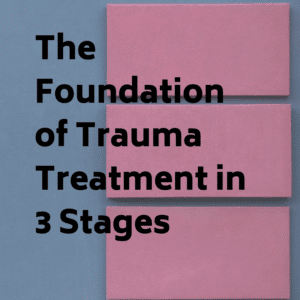
Trauma treatment can be a complex landscape to navigate with a client. It is easy to lose focus in your treatment plan or get redirected by the latest crisis that is happening for your client. It is also easy, for you as the therapist, to become overwhelmed with all the moving parts when treating trauma. Having a foundation to guide you in treatment helps to conceptualize your case, have a clear focus, and give your client assurance of their goals and next steps in the treatment process.
We All Start Out With Good Intentions
I am like you…I start out each case with the desire to be helpful. I am passionate about trauma treatment and I want the best for all my clients. However, sometimes I find myself wondering “where do I start?” Many of my clients have complex stories and multiple stressors when we begin. We could be moving along in the treatment process and a situation or circumstance in my client’s life comes along and introduces yet more stressors. And as we know, stress can be very triggering to trauma survivors. Then I am faced with the question of which direction to move in as it relates to their treatment.
These questions and many more were a daily occurrence for me, and I found myself not quite sure what to do. Then I ran across an article that mentioned Dr. Judith Herman’s 3 Stages of Trauma Treatment and the light bulbs started to go off…this was my answer.
Dr. Judith Herman wrote “Trauma and Recovery” in 1992 and it is one of the classics when talking about treating trauma. In this book, she goes into 3 stages of trauma treatment. I adapted those stages for myself and came up with my foundation for trauma treatment. It is my guiding light for those chaotic or emotionally overwhelming times with clients.
The Three Stages
I use these three stages to provide psychoeducation to my clients, conceptualize their cases, and track direction and progress in treatment. The three stages I like to think through are below:
Safety and Stabilization Stage
In this stage, I am helping a client establish a sense of safety within themselves, within relationships, and within the world. Once they can maintain this sense of safety the next goal is to help them create a toolbox of coping skills that are internal and external. These coping skills teach clients to establish and maintain stabilization also knows as emotional regulation.
Processing Stage
At this stage in treatment, I use various modalities to help clients work through the content and narrative of the traumatic things that have happened to them. We might start with past experiences or present-day experiences that trigger old patterns in their mind and body. While in this stage I remain attuned to the client’s safety and stabilization.
Moving On Stage
This is the part of the client’s treatment where they reconnect by socially engaging with people and the world with a new meaning related to their traumatic experience. This is the stage where clients feel motivated and strong enough to take a risk and make changes, while also being relaxed enough to integrate these new experiences into their lives and their new narrative.
Having these three stages to refer to as I assist clients in healing from trauma keeps me from feeling lost, overwhelmed, and ineffective in my treatment. With this foundation, I am able to find my footing and move with purpose and direction in the treatment process. To learn more about these three stages of trauma treatment consider this online course.
Comment Below:
What framework do you use to help you conceptualize a trauma treatment plan?


2 Responses
Thanks for also talking about how stabilization is one of the things to focus on first when undergoing trauma treatment. I’m interested in looking for a good clinic that offers that kind of treatment because my daughter recently experienced a car accident. Though she wasn’t injured, she was pretty rattled by the experience to the point that she gets anxious whenever she’s inside a car.
I am glad your daughter is okay. I would suggest that you look for Somatic Expereincing Practioner in your area. You can search their directory at https://directory.traumahealing.org/. I wish you both well in her healing journey.